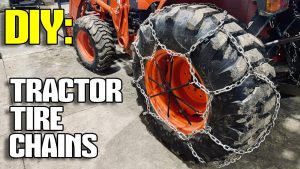Explore the evolution of chains in tractor tires, from early designs to modern innovations and future trends in chain technology.Tractor tire chains have a rich history, evolving significantly from their early use to the advanced designs we see today. Initially developed to enhance traction on challenging terrains, these chains have become an essential tool for farmers and industrial operators alike. As technology progressed, innovations in chain design emerged, leading to improved durability and performance under various conditions. This blog post will explore the historical journey of tractor tire chains, highlighting their early applications, the innovations that shaped their development, and the numerous benefits they offer. We’ll also delve into modern production techniques that enhance chain quality and examine the future trends poised to revolutionize chain technology even further. Join us as we unravel the fascinating evolution of chains for tractor tires and their impact on agriculture and industry.
Early Use of Chains
The early use of chains dates back to ancient civilizations where they served various practical purposes. Initially, chains were crafted from metals, used prominently in the construction of buildings and in transport systems. However, the concept of chains eventually found its way into agriculture, particularly in relation to tractors.
One notable innovation was the adaptation of chains for use as tire traction. This adaptation allowed for better grip on uneven and muddy terrains, significantly improving the efficiency of agricultural operations. Farmers discovered that adding chains to tractor tires minimized slippage, enhancing the vehicle’s ability to traverse challenging landscapes.
These early chains were often made of wrought iron and featured simple designs, but their effectiveness in improving traction cannot be understated. The design and structure of these chains have since evolved, leading to more sophisticated options that are widely used today.
Innovation in Chain Design
The design of chains for tractor tires has undergone significant transformation over the years. Initially, these chains were simple and utilitarian, primarily serving the purpose of enhancing traction and stability on various terrains. However, with advancements in technology and materials, modern chain designs have evolved to offer superior performance and durability.
One of the most notable innovations in chain design is the development of modular chains. These chains can be customized according to the specific needs of tractors, allowing farmers to mix and match links based on different soil types and conditions. This adaptability ensures that tractors maintain optimal traction regardless of whether they are operating on muddy fields or rocky landscapes.
Another key advancement has been the use of high-performance materials. Today’s chains are often made from alloys that resist wear and corrosion, resulting in enhanced longevity and reduced maintenance costs. Innovative designs also incorporate features such as diamond-pattern links, which further improve grip and prevent slippage, making farming operations more efficient.
The evolution of chain design reflects the ongoing need for flexibility and efficiency in agricultural practices.
Moreover, manufacturers are also exploring the use of 3D printing technology to produce chains more rapidly and at lower costs. This method allows for greater precision in design, which can lead to the creation of chains that are lighter yet more robust, ultimately benefiting farmers by making machinery easier to operate and maintain.
Benefits of Chains for Tractor Tires
Chains for tractor tires provide numerous benefits that enhance both performance and safety. One of the primary advantages of using chains is improved traction. When traction is critical, such as in muddy or icy conditions, chains dig into the surface, providing greater grip.
Another significant benefit is increased stability. Chains help distribute the weight of the vehicle more evenly across the tires. This stability is essential when navigating uneven or rugged terrain, reducing the risk of tipping or losing control.
Additionally, chains can extend the life of tires. By reducing slippage and wear on the tires, you not only save money on replacements but also maintain better fuel efficiency over time. Investing in a good set of chains can pay off in both performance and cost-effectiveness.
Modern Production Techniques
In the realm of tractor tire chains, modern production techniques have significantly transformed their design and functionality. With advancements in technology, manufacturers have been able to enhance the quality and durability of chains, ensuring they meet the demands of contemporary agricultural practices.
One notable development is the use of computer-aided design (CAD) systems, which allows engineers to create precise models of chains before production begins. This not only speeds up the design process but also minimizes errors, leading to higher-quality products. Furthermore, the integration of 3D printing technology enables the prototyping of complex chain designs, facilitating rapid iteration and innovation in the manufacturing process.
Another important technique is the adoption of advanced material science. By utilizing high-strength alloys and specialized coatings, today’s tractor tire chains are not only more robust but also more resistant to wear and corrosion. This results in a longer lifespan for the chains, ultimately reducing maintenance costs for farmers and enhancing their productivity.
Moreover, the implementation of automated manufacturing processes has revolutionized production efficiency. Automated systems can produce chains at a much faster rate while maintaining consistent quality. This shift not only improves output but also allows for scalability, meeting the increasing demands of the agricultural sector.
In summary, the evolution of modern production techniques has played a crucial role in enhancing the performance and reliability of tractor tire chains. Through innovations like CAD, 3D printing, advanced materials, and automation, manufacturers are well-equipped to meet the growing needs of today’s agricultural landscape.
Future Trends in Chain Technology
The future trends in chain technology for tractor tires are set to enhance performance and durability significantly. As the agricultural industry evolves, so do the technologies that support it. Manufacturers are increasingly investing in research and development to create innovative chains that can withstand the demands of modern farming while providing immense benefits.
One of the most promising trends is the integration of smart technology in chains. Using sensors embedded within chains, farmers can monitor real-time data about tire pressure, wear, and environmental conditions. This technology allows for more efficient maintenance schedules, reducing downtime and increasing productivity.
Furthermore, advancements in materials are paving the way for lightweight yet strong chains. The use of composite materials and advanced metallurgy not only enhances the durability of chains but also improves fuel efficiency by reducing the overall weight of tractor tires. This shift towards sustainability and efficiency will likely shape the future of chain technology.
In addition, the development of eco-friendly production methods is gaining traction. Manufacturers are exploring ways to recycle old chains and utilize biodegradable materials, aligning with the broader goal of minimizing the environmental impact of agricultural practices. This commitment to sustainability is becoming a key focus for both producers and consumers.
As we look forward, it is clear that and chain technology for tractor tires will continue to evolve, driven by the demands of modern agriculture and advancements in technology.
Frequently Asked Questions
What are tire chains used for in agriculture?
Tire chains are used to improve traction on slippery surfaces, such as mud, snow, or ice, thereby enhancing the performance and safety of agricultural machinery.
When were tire chains for tractors first developed?
Tire chains for tractors were first developed in the early 20th century, around the same time that tractors became more widely adopted in farming.
How have tractor tire chains evolved over the years?
Tractor tire chains have evolved from simple, relatively crude designs to more sophisticated, heavy-duty chains that are engineered for specific tractor tire sizes and applications, incorporating advanced materials for durability.
What materials are commonly used in manufacturing tractor tire chains?
Common materials for manufacturing tractor tire chains include steel for strength and durability, and sometimes lighter alloys to create chains that are easier to handle.
What are the benefits of using chains on tractor tires?
The benefits of using chains on tractor tires include increased grip and stability, reduced wheel slippage, enhanced safety during challenging weather conditions, and improved efficiency in agricultural tasks.
Are there different types of tire chains available for tractors?
Yes, there are several types of tire chains available for tractors, including ladder chains, diamond pattern chains, and cross-link chains, each designed for specific traction needs and operating conditions.
What should farmers consider when choosing chains for their tractor tires?
Farmers should consider factors such as the specific terrain and weather conditions they operate in, the size of their tractor tires, and the type of tasks they will be performing when choosing chains for their tractor tires.





